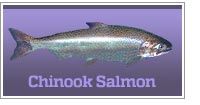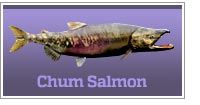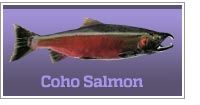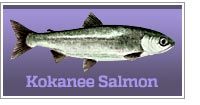Fishing For Salmon In Oregon
Guide to fishing for chinook, chum, coho and kokanee salmon in OR.
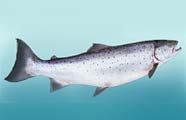
Oregon is renowned for its incredible salmon fishing opportunities, attracting anglers from all over the world. The purpose of this page is to share basic information about salmon fishing and identify popular salmon waters in the state. Several salmon species can be targeted in the state's coastal waters and rivers, offering thrilling angling experiences.
Chinook salmon, also known as king salmon, are highly prized for their large size and powerful fights. These iconic fish can weigh over 50 pounds and are known for their acrobatic leaps and strong runs. Chinook salmon return to Oregon's coastal rivers and streams to spawn, creating prime fishing opportunities. The Tillamook Bay, the Columbia River, and the Rogue River are popular destinations for Chinook salmon fishing in Oregon.
Coho salmon, also called silver salmon, are another sought-after species among anglers. These fish are known for their aggressive strikes and impressive stamina. Coho salmon provide an exciting challenge for anglers of all skill levels. They can be found in coastal rivers and streams during their annual migration for spawning. The Siuslaw River, Nehalem River, and the Umpqua River are renowned for their Coho salmon runs in Oregon.
In addition to Chinook and Coho salmon, Oregon also has opportunities to catch other salmon species. Sockeye salmon, while less common, can be found in certain rivers and lakes in the state. Chum salmon and pink salmon are occasional visitors, primarily during specific runs or unique circumstances.
Salmon fishing in Oregon can be done from both boats and the shore, depending on the location and preferred method. Anglers employ various techniques such as trolling, casting, or fly fishing to target salmon. Baits and lures such as plugs, spoons, and baitfish imitations are commonly used to entice strikes from these powerful fish.
It's important for anglers to familiarize themselves with the fishing regulations and guidelines set by the Oregon Department of Fish and Wildlife when pursuing salmon. This includes understanding the specific seasons, size and bag limits, and any special regulations for certain rivers or areas. Respecting these regulations helps preserve the health and sustainability of the salmon populations for future generations of anglers.
Oregon's salmon fishing is not only a thrilling angling experience but also an opportunity to connect with the state's natural beauty and witness the awe-inspiring life cycle of these incredible fish. Whether you're targeting Chinook salmon, Coho salmon, or other salmon species, Oregon's waters provide a memorable fishing adventure and a chance to reel in these majestic creatures.
The major reservoirs offering salmon fishing in Oregon include Agency Lake, Crane Prairie Lake, Crescent Lake, Detroit Lake, Green Peter Lake, Lake Billy Chinook, Odell Lake, Phillips Lake, Siltcoos Lake, Upper Klamath Lake and Wickiup Reservoir. Several lakes in the state provide ice fishing for salmon.
Fishing for salmon in Oregon
Chinook salmon
World record: 97 lbs 4 oz
State Record: 83.0 lbs
Chum salmon
World record: 35 lbs 0 oz
State Record: 23.0 lbs
Coho salmon
World record: 33 lbs 7 oz
State Record: 25 lbs 5.25 oz
Kokanee salmon
World record: 9 lbs 10 oz
State Record: 9 lbs 10.72 oz
Click the images and links above for species details.
Oregon State Record Salmon
The state record chinook salmon came from the Umpqua River.
The state record chum salmon was caught in the Kilchis River.
The state record coho salmon was caught from Siltcoos Lake.
The record kokanee salmon was taken out of Wallowa Lake.
About The Pacific Salmon Family
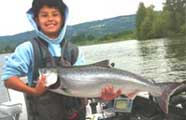
Pacific Salmon are born in and remain in freshwater streams for the early years of life. The number varies by species. Afterward they migrate to the Pacific Ocean waters where they bulk up and prepare for their once in a lifetime spawning run up the freshwater stream where they were born. They will instinctively return to their birthplace, spawn and die. They are found in the streams which empty into the ocean, and adjoining ocean waters.
The preferred method for catching salmon is fly fishing. Depending on the activity level, salmon may be caught on wet or dry flies. For more details check here for articles about fly fishing.
Salmon Organizations
Oregon Salmon Fishing
The preferred method for catching salmon is fly fishing. Depending on the activity level, salmon may be caught on wet or dry flies, as well as a variety of other lures and baits.
Salmon fishing waters and information, by state.
Learn the life cycle of salmon
The more you know about the life cycle and seasonal migration of salmon, the more likely you are to be looking in the right area next time you visit Oregon salmon fishing waters. Visit the salmon fishing page for more information about the life cycle of the different species of salmon.
Contribute OR Salmon Fishing Knowledge
If you have information, articles or photos relating to salmon fishing in Oregon, which you would like to see published here, please submit them for consideration.
OREGON




